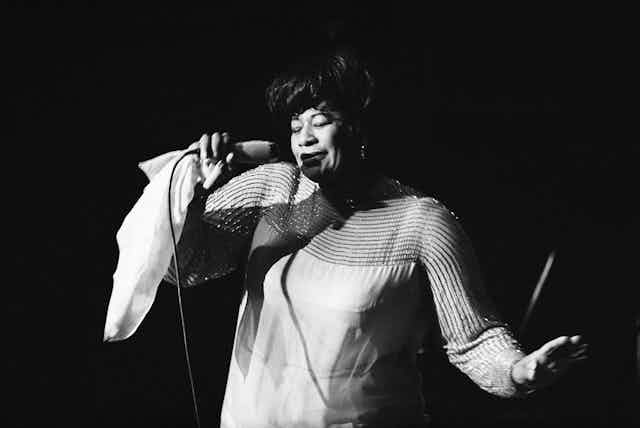Christmas. High time for re-releasing classic recordings from famous singers from the past. It’s that time of year when TV, radio, newspapers and websites advertise music from much-loved “legends” like Elvis Presley, Frank Sinatra and Dean Martin.
When it does this, the music industry is well aware of three things: this is the season when consumers’ appetite for any old song that will feed that nostalgic mood peaks; artists and repertoire from the remote 1950s and 1960s are more suitable for romanticised family gatherings; and everyone has a hard time deciding which Christmas present they should buy for that very particular uncle whose musical curiosity gave up on him 30 years ago.
This year there is a “new” album by Ella Fitzgerald “with” the London Symphony Orchestra featuring a “duet” with contemporary jazz singer Gregory Porter. The reason I’ve just put some words in quotation marks is simple – they’re not true. Fitzgerald died in 1996 and Porter started his career in 2004 doubling as chef and singer at the now defunct Bread-Stuy restaurant, in Brooklyn.
However, Someone to Watch Over Me is being advertised as new. And, to some extent, it is. Using a couple of albums made in the early 1950s where Fitzgerald sings Gershwin and various songs from the Great American Songbook, technicians were able to isolate her voice, record the orchestra separately and then blend it all together. A remarkable new product, made possible by state-of-the-art audio technology.
But is this ethically acceptable? Is it okay to manipulate the recorded work of dead artists to our own preference? Where do we draw the line between paying tribute to popular artists and exploiting their legacy? One thing is certain when it comes to Someone to Watch Over Me: no one asked Fitzgerald.
Every Christmas, artists seem blindly drawn to sing a duet with dead people they admire. Susan Boyle’s 2013 Christmas holiday album features her rendition of O Come, All Ye Faithful in a posthumous duet with Elvis Presley. Rod Stewart’s 2012 Merry Christmas, Baby album includes another duet with Ella Fitzgerald on What Are You Doing New Year’s Eve?. And the promotional single for Dean Martin’s 2011 retrospective collection of Christmas songs, My Kind of Christmas, was a duet with Hollywood star Scarlett Johansson on I’ll be Home for Christmas.
Although this is more common at Christmas, it happens all year round. The music world was clearly divided when Natalie Cole decided to make a record with the voice of her dead father, Nat King Cole. Unforgettable With Love became a huge commercial success and went on to win a Grammy for Best Album the Year in 1991.
Less divided was the audience at the 1997 tribute concert that marked the 20th anniversary of Elvis Presley’s death, when his daughter Lisa Marie Presley sang a duet with a video of her father on Don’t Cry Daddy.
However, in most cases, what might have started as a very sincere way of paying tribute to past artists, ends up being seen as a pathetic attempt to rub shoulders with timeless music icons. In 2000, saxophonist Kenny G got a taste of how such attempts can backlash in a rather bitter way.
Musical necrophilia
When he overdubbed his saxophone on to Louis Armstrong’s What a Wonderful World, the jazz world didn’t show any kind of sympathy – on the contrary, jazz guitarist Pat Metheny called it “musical necrophilia”. And, despite receiving his 15th Grammy nomination with the album My Dream Duets in 2015, featuring duets exclusively with dead artists, Barry Manilow was criticised for it and included in the Guardian’s list of “the creepiest duets with dead singers”.
Dead artists are also being forced back into the business in hologram form. Celine Dion performed a duet on American Idol side by side with the King himself. Elvis was also forced into a duet with country singer Martina McBride who sandwiched herself into his classic rendition of Blue Christmas. However, Christina Aguilera’s planned duet with Whitney Huston was pulled before it got to air.
In one of the original recordings used to rip Fitzgerald’s voice, Ella Sings Gershwin, she is responding to a pianist (the discrete but amazing Ellis Larkins, who was utterly obliterated from the 2017 version). Fitzgerald was known for being able to interpret the same song in an absolutely new and exciting way every time she sang it. It is fair to assume that she would most likely respond differently to an orchestra.
And that response is the actual voice of the artist. Records are more than sound – they document a moment in time of a unique interaction between musicians, producer, technicians and even the recording room. Technology is very useful when it comes to restoring priceless recordings, enabling them to be enjoyed today. That is respecting the past and heritage. Using that technology to sell a Christmas album is a completely different agenda.

